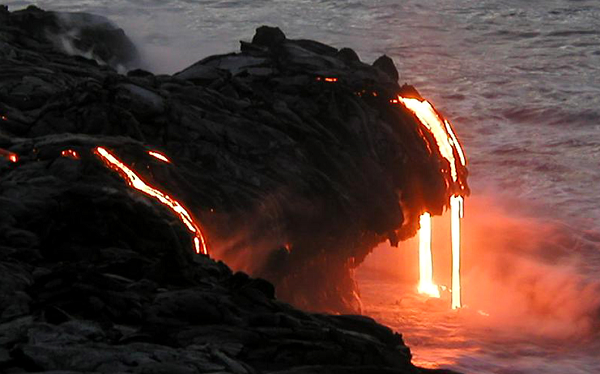Kilauea Volcano Photos: Hawaii Lava Flow Cut Off After Portion Of Cliff Collapses

The firehose lava flow that had been spilling out of a seaside cliff on Hawaii’s Kilauea volcano since New Year’s Eve finally stopped Thursday after a portion of the cliff collapsed, according to reports. Hawaii Volcano Observatory geologists were at the site observing a large crack in a section of the cliff and were able to catch video footage of the collapse, which blocked the opening of the eastern seaside cliff that had been gushing out molten hot lava for weeks.
Tourists were also in the area at the time of the collapse, and later that same day guests on a tour boat near Kilauea’s shoreline recorded videos of a second section of the cliff collapsing, sending debris into the air and a causing a large piece of land to fall into the ocean just a few feet ahead of the boat.
Spectacular lava footage from #Kilauea. Check out the boat 45-seconds into video. That'd be too close for me! https://t.co/dQ6ufDjVGX
— Gordon Deal (@GordonDeal) February 2, 2017
Although the collapse stopped the stream of lava, Hawaii Volcano Observatory officials said Sunday Kilauea was still active at its summit and East Rift Zone and that the lava was still able to flow into the ocean at Kamokuna’s entry, but not of the same magnitude as before the collapse. The observatory said that surface lava flow was still prevalent within 1.5 miles of the volcano’s vent at Pu’u O’o.
#Kilauea #OceanEntry sea cliff #collapsed yesterday at 12:55 p.m. Video captured the moment of collapse. https://t.co/A5JBK9flxY pic.twitter.com/7ORiXqQqfk
— USGS Volcanoes🌋 (@USGSVolcanoes) February 3, 2017
Hawaii Volcano Observatory didn’t expect the remaining lava flow to be a threat to nearby areas. However, Janet Babb, a USGS geologist, told local media Friday Thursday’s collapse didn’t necessarily mean the area was in in the clear and that other areas of the unstable cliff could still break off at any time.
“This collapse yesterday did not diminish the hazards,” she said. “As long as lava continues to flow into the ocean, that area is still quite hazardous. There’s still potential for collapses of the sea cliff there.”
As @USGSVolcanoes warned: Sea cliff at Kamokuna ocean entry collapses. #Kilauea #volcano https://t.co/VUK0jImm17 pic.twitter.com/FxdqObTJSV
— Dr Janine Krippner (@janinekrippner) February 3, 2017
Babb said explosions caused by molten lava hitting the salty ocean water could also send large chunks of hot rock and debris inland. Gasses released from the explosion could also be dangerous.
There are very real #hazards associated with getting too close to #Kilauea #firehose of #lava. #StayBack #StaySafe https://t.co/A5JBK9flxY pic.twitter.com/YQLDpuGXYo
— USGS Volcanoes🌋 (@USGSVolcanoes) February 2, 2017
Kilauea’s firehose flow first started on New Year’s Eve after 21 acres of lava delta collapsed into the ocean, exposing a lava tube at Kamokuna’s seaside entry. In most cases, lava streams last about one to two days.
© Copyright IBTimes 2025. All rights reserved.






















